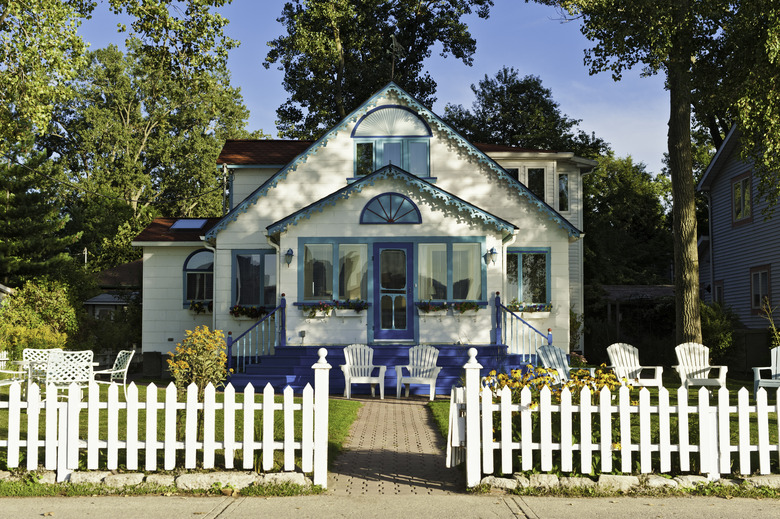How To Build A Picket Fence: A DIY Guide
We may receive a commission on purchases made from links.
The picket fence remains a charming favorite of many homeowners, partly because it gives people a sense of nostalgia and partly because there are functional benefits to a picket fence. In addition to curb appeal, it provides a firm yet welcoming boundary that does not give the appearance of separation and blocking the outside like many fences do.
If you've decided to install a picket fence on your property, this is an excellent DIY project for a relatively handy homeowner with a basic knowledge of how to use tools. A picket fence is a simple structure, and many large home centers offer prefab fence panels that come with the pickets already installed and placed. However, by building the picket fence yourself, you'll be able to get creative and implement your own style and tastes to give it your own custom design.
Picket Fence Parts
Picket Fence Parts
Building a picket fence is actually less complicated than building a kid's LEGO set. It's a lot less arduous, really, because a picket fence is comprised of only three basic parts: posts, pickets and rails. Then, there are the extras: nails or screws, paint or stain and decorative caps. The body of a picket fence has only three parts, and unlike that frustrating LEGO set, they all go the same way and don't require a 20-page manual to assemble.
The fence posts are installed in the ground approximately 6 to 8 feet apart depending on personal taste and the landscape. For example, if there are large tree roots or rocks in the area, you may need to adjust the length between posts to keep it symmetrical. You can change the post and rail lumber sizes according to your design, but a square 4x4 is a good standard size for a post, and rails are generally 2x4s. The horizontal rails connect the posts, with two between each post an equal distance apart. The pickets are connected to the rails.
The pickets can vary in width according to taste along with the space between them. According to Old House Online, the pickets for a standard picket fence are typically 2 1/4 inches to 3 inches in width, with a square cut on top. This is not set in stone, though, and you can use your creativity to install a wider or narrower width and select a spear, pointed or rounded picket to give your picket fence its own original design. Purchasing your own individual fence posts from a fence manufacturer will save time and work, but if the size or design you want is not available, you can customize your pickets or create your own using standard 1-by lumber.
Spacing between the pickets is something else that can be adjusted according to taste and function. The pickets are typically spaced the width of one picket apart, and bringing them closer together or further apart will affect visibility and privacy. You can find what you like best by tacking a few pickets at different spaces to the fence rails to give you an idea of which one you find most aesthetically pleasing. If you have children or pets, you shouldn't have a space that's too wide, similar to a stairway railing. For a home with children, use a space less than 4 inches between pickets to keep them safe (and to prevent any little curious heads from poking through and getting stuck).
Picket Fence Preparation and Guidelines
Picket Fence Preparation and Guidelines
While you can insert your own style to certain parts of your fence installation, there are certain rules and guidelines for the installation process to which you should adhere. Before building your picket fence, check with your local municipality to see if a permit is required to build a fence. Codes regarding fence size and style as well as post-hole requirements can vary from town to town. If you have a homeowners' association, check with it as well. You should also contact your local utility companies before digging holes for your posts.
A classic wood picket fence should be 3 to 4 feet tall, but because you want everything to be in proportion, the height will vary according to the house and property. A 3-foot fence may be perfect aesthetically for a small ranch or cottage, while a larger home or one with a big yard will look better with a taller 4-foot fence. It's very important that everything is kept straight and level during installation. Posts and rails should be straight and even, and pickets should be plumb and evenly spaced. Having a helper will make the fence installation go much quicker and easier, especially when setting the posts.
You have two basic options for the post installation: setting them in concrete or in gravel. While this is a personal decision, gravel is usually a better choice for a picket fence. Concrete will keep a fence secure, particularly in high winds, although wind does not affect a picket fence like it does a solid fence. Concrete also does not protect against moisture and rot and makes removal difficult, while gravel helps to forestall rot by letting ground moisture drain away from the post. If you ever need to replace a post or rebuild the fence, removing a post from gravel is relatively easy.
Painting or staining the fence is another factor to consider. The color that often comes to mind when imagining a picket fence is white, but a fence can be any color you choose (disregarding any HOA requirements in your particular neighborhood). While it's tempting to paint your posts, rails and pickets beforehand to make the job easier, whether or not to do this depends on the type of wood you use for your fence.
Cedar, for example, can be painted right away, and allowing it to weather too long before painting can result in more prep work when you finally do paint. On the other hand, pressure-treated wood should be allowed to dry for three to four months before painting or staining. Make sure to look into painting guidelines for the type of wood you use before painting or staining your picket fence.
How to Build a Picket Fence
1. Mark a Straight Line
Drive a small stake into the ground at both edges of the location where you plan to build the picket fence. Run a piece of string between the stakes, keeping it 6 inches off the ground. This will allow you to line up the fence posts in a straight line. Measure and mark the center of each fence post location on the ground with spray paint or with a stake. The posts should be a maximum of 8 feet apart and must be spaced evenly.
2. Dig the Post Holes
Using a post-hole digger and a shovel, dig all of your fence post holes. If your fence is large and there are a lot of holes to dig, using a post-hole power auger can make the job easier while saving time and possibly a lot of back pain. The holes should be approximately 2 feet deep with an additional 4 inches for the addition of gravel.
A common rule of thumb for fence posts is to have 1/3 of the post in the ground and 2/3 above ground. Because a picket fence should be around 4 feet tall, use 6-foot posts. If your fence will be less than 4 feet tall, increase the depth of the hole or cut the posts to accommodate the difference.
3. Set the Fence Posts
Use a pencil to mark each post 4 feet (or whatever height your fence will be) from the top, subtracting the 6-inch string height you used in step one. Use this as a guideline to keep all of your posts the same height. Pour a 4-inch layer of crushed gravel into the first hole. Set the post into the hole. Pour in five more inches of gravel around the post and tamp it down using a level or a post level to make sure the post is plumb.
Repeat until the gravel is a few inches from the top of the hole and then top it off with soil. Do the same with each post. If you chose to set the posts in concrete, fill around the post with concrete that stops a few inches short from the top of the hole. Top off the hole with soil after the concrete hardens.
4. Mark the Rail Locations
Measure down from the top of each post and make a mark at 8 inches and approximately 28 to 30 inches. This is where the top of your fence rails will be located. A standard rule of thumb is to place the top rail approximately 8 inches from the top of the fence and the bottom rail approximately 8 inches from the grade, although these measurements can be altered to fit your design.
5. Install the Rails
Measure the distance between the posts and cut the 2x4 rails to fit. To each post, add 3 inches to the distance between the posts. This will allow an overlap of 1 1/2 inches on each side to secure each end to a post. Fasten the rails to the posts using deck screws or galvanized nails, although screws are easier to remove should that ever be necessary.
6. Cut the Pickets
Determine the picket height in relation to the posts and the ground. It's a good idea to leave a 2-inch gap between the bottom of the picket and the ground to prevent rotting and warping and to allow room to cut the grass. Cut each picket to the desired length using a miter saw to ensure a straight cut. Determine the space you want between pickets and cut a spacer to use between the pickets to keep them spaced evenly during installation.
7. Mark the Picket Height With String
Measure and mark on your posts the desired height of the top of your pickets. Tie or clamp a string to the posts to serve as a guide for the picket height. Make sure the string is tight and has no slack. Repeat this between each fence post.
8. Install the Pickets
Lining up the top of the pickets with the guide string and using the precut spacer between pickets, install the pickets and fasten with exterior-grade deck screws or nails. Even though you are using a spacer, check each picket with a level before and after installing to make sure it is plumb before moving on to the next picket.

